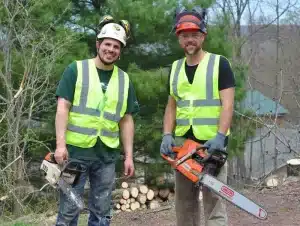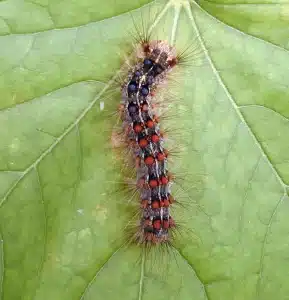Has your yard started to look like fall came early? Are your trees shedding leaves like they’re trying to beat the October rush? Don’t worry—you’re not alone. All over the region, trees are going bare(ish) weeks ahead of schedule, and no, they’re not confused about the seasons. They’re reacting to something else entirely: there’s fungus among us!
What’s going on?
This year has been a nonstop soggy rain fest. Downpours. Mud. Mushy lawns. Perfect conditions… for fungal infections. The biggest culprit? A common leaf disease called anthracnose.
Anthracnose is caused by a group of fungal pathogens that thrive in cool, wet weather—like the endless drizzle we’ve had this spring. The spores spread by wind and rain splash, infecting young, tender leaves. Infected leaves often show irregular brown or black blotches, curling edges, or distortion. Often they’re stunted and, in many cases, the tree decides to drop those infected leaves altogether, which is why your yard might look like a leafy confetti explosion right now.
Who’s affected?
Soft maples, oaks, ash, crabapples, dogwoods, sycamores—you name it.
Here’s what I’ve seen lately:
Oaks with wilted, brown-spotted, curling leaves
Crabapples with blotchy, brown-speckled foliage (classic apple scab)
Sycamores that are half-naked already
Maples shedding leaves like it’s going out of style
Should I panic?
In most cases: nope. Think of this like your tree having a rough spring cold. Leaf loss this early in the season can look dramatic, but it rarely kills a healthy tree. Most trees will push out a second flush of leaves by mid-summer, especially if we get a stretch of drier, sunnier days.
Here’s what you can do if your tree is looking a little “down and out”:
Rake up and dispose of fallen leaves. Fungal spores love to hang around in leaf litter, waiting for round two. Get rid of them.
Avoid pruning or fertilizing right now. Let your tree recover naturally. Overreacting can do more harm than good.
Mulch right. No volcano mulching! A 2–3” donut-shaped layer of mulch (not touching the trunk) helps retain moisture without smothering roots.
Call an arborist if you’re unsure. Especially if your tree is very young, stressed, or not putting out new growth.
If your yard looks like a tree gave up on summer, don’t panic. Most trees can handle a little fungal setback and will bounce back just fine. Keep an eye on things, tidy up the leaf litter, and give your trees some space to recover. A little patience—and hopefully a little sunshine—go a long way.
If you’re looking to prevent this kind of thing in the future, a solid plant healthcare plan—whether DIY or with a pro—can go a long way. Healthy soil, proper care, and a bit of well-timed attention can help trees stand strong when the next soggy spring rolls around.
After all, even trees have rough seasons.They just can’t call in sick or binge-watch Netflix in bed.
Mike White is an ISA board certified master arborist and owner of Treemaster LLC. If you’re interested in learning more about tree related issues, you’ll find him to be moderately obsessed. You can reach him at mike@treemasterllc.com.




